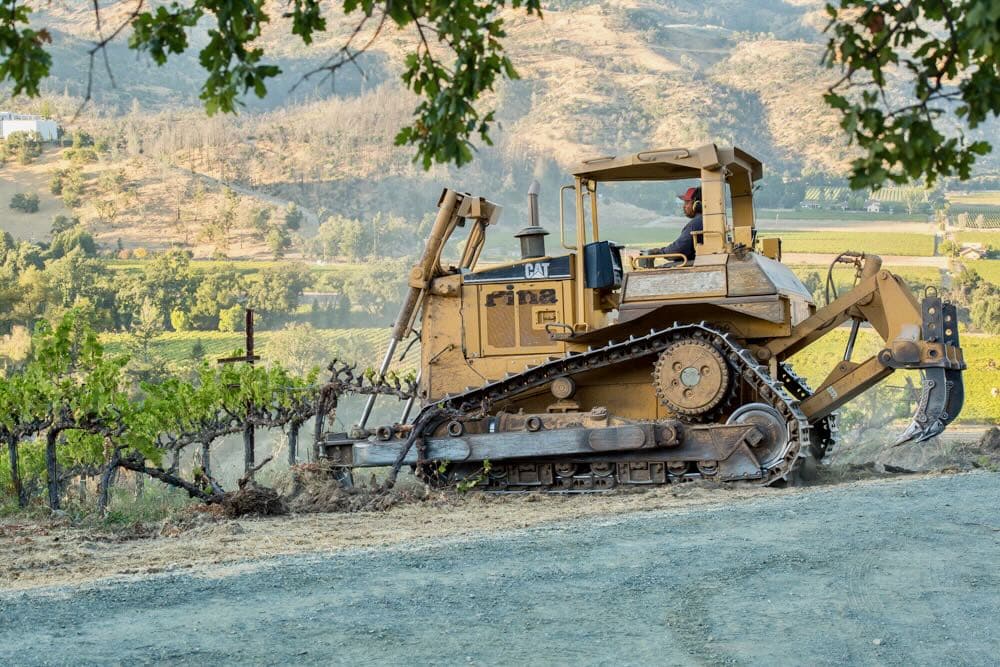Operation Vine Removal and Replanting

Operation Vine Removal and Replanting
Castello di Amorosa, nestled in the hills just south of Calistoga in the northern end of Napa Valley, has long been a symbol of tradition, craftsmanship, and excellence. The Castello, built by pioneer winemaker and winery owner, Dario Sattui, has been recognized as an architectural masterpiece that combines centuries-old medieval material with state-of-the-art winemaking equipment.
For over 25 years, lush rows of Cabernet Sauvignon, Merlot, Sangiovese, Malbec, Primitivo and Petit Verdot vines surrounding the Castello have produced some of the region’s most coveted wines.

But change is in the air around the Castello. Starting in late September 2024, the vineyard will undergo a remarkable transformation—its iconic vines, which have given so much over the years, are being removed.

Time is of the essence. Erosion control ordinances require the vines to be removed and the erosion control to be implemented before October 15 and no work can be done until the following April when planting will begin. Vineyard blocks 5, 7 and 10 will be planted in April of 2025. The investment in vine removal and replanting is $1,000,000 for the ten acres of blocks being replanted.




Over time, even the best vines begin to show their age. Though the wines from Castello di Amorosa have remained stellar, the vineyard’s team, led by visionary vintner, Dario Sattui, Castello President, Georg Salzner and Director of Winemaking, Brooks Painter, knew it was time to embrace renewal. “It’s a bittersweet moment as I can vividly recall the first planting of the Castello vineyards,” Sattui said, “but if we want to continue producing the highest quality wines for the next generation, we must replant. The terroir is the same, but the potential for what we can achieve is limitless.”
As we await the perfect moment to harvest, the work in our vineyards never ceases. One of the most important tasks at hand is ensuring our vineyards continue to thrive and produce exceptional fruit for future vintages. While many factors can influence the yield of grapes, the longevity of the vineyard depends heavily on the strategic replanting and care of the vines themselves.
As Dario Sattui explains, “Vines, like everything in nature, have a life cycle. While some vines can live for over 100 years, most of our vines reach their peak around 25 to 30 years. At this stage, their ability to produce optimal fruit diminishes, and that’s when we know it’s time to invest in the future of our vineyard.”
For Castello di Amorosa, this means carefully replanting select blocks of the vineyard, including blocks 5, 7 and 10, with Cabernet Sauvignon in 2025. The decision to replant isn’t made lightly, as it requires patience and foresight. By removing entire blocks, we have the unique opportunity to introduce new, disease-resistant rootstocks and clones of Cabernet Sauvignon that will elevate our winemaking legacy. “Replanting is a chance to secure our future,” Dario adds, “to ensure that Cabernet Sauvignon remains a cornerstone of our vineyards, delivering the quality and character our wines are known for.”
This process is about more than simply pulling out old vines; it’s about maintaining a balance between the vineyard’s current productivity and long-term prosperity. While pulling full blocks means those areas won’t yield grapes for a few years, the investment we’re making today is what will ensure Castello di Amorosa remains at the forefront of Napa Valley winemaking.
Gallery
Click on the images below to see them in high definition

Jim Sullivan
Jim Sullivan, Vice President of Public Relations and Marketing spearheads Castello di Amorosa’s publicity and marketing initiatives.
With over 20 years of marketing, public relations and business development experience with professional motorsports teams and in a variety of healthcare organizations in Southern California, Jim first joined Castello di Amorosa in 2008 as Public Relations and Marketing Manager.
An avid cyclist, Jim fell in love with wine and wineries while exploring the Washington State countryside. His love of wine was reinforced during subsequent trips to the Napa Valley to visit family.
Jim holds an MBA from the University of Redlands and a Bachelor of Science from Central Washington University. He resides in Calistoga, Calif.








